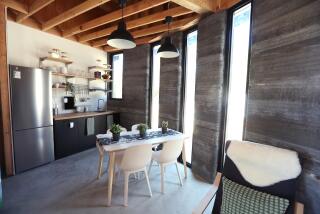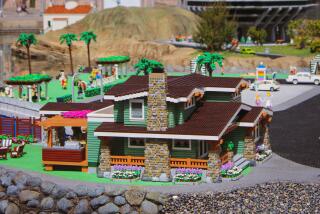In era of steel and glass, Team Austria builds a beauty in wood
- Share via
Although it was designed in Vienna, Team Austria’s entry for the 2013 Solar Decathlon seems better suited to the event’s sun-washed setting in Southern California. Wall-to-wall sliding glass pocket doors open up most of the home to the outdoors, including two large decks. Breezes flow through without impediment.
Native California plants -- rented for the decathlon, so as not to waste resources -- sit at your feet on the porch, and above float fabric canopies that can retract when the sun isn’t out.
“We studied the California climate very carefully,” team member Katharina Bauer said.
Clad in a wispy white camouflage curtain -- fabric used by the military for snowy locales -- the Team Austria house is the closest to sexy in the competition. You could see it on the cover of W Magazine, the backdrop for a couple of models.
PHOTO GALLERY: Team Austria’s entry in Solar Decathlon
Inside the home is basically one giant, seamless living space. Sure, there is a tiny bedroom and bathroom, but like every element -- the refrigerator, the TV, the washing machine -- they’re hidden behind wood wall panels.
In fact about 96% of the home is made of wood-based materials --biodegradable and plentiful in the forests of Austria.
Solar Decathlon 2013: Team profiles, contest results, design trends
“We tried to use every part of the tree, so there was no waste,” team member Daniel Kuenz said. One wall is clad in oak, another in ash; the ceiling is cloaked in fir. The bathroom is covered with baked thermal ash, which is waterproof and cozier than tile. The bedroom, cocoon-like and barely larger than the bed itself, is lined with chipped bark, giving it a dark, rustic character. Even the curvy dining chairs are made of molded bark and sawmill dust.
A utility closet contains the monitors and controls for all the high-tech functions of the house, including radiant heating and cooling, automated shades and awnings, and the entertainment system. Radar and sensors on electrical outlets can give occupants information about energy usage -- down to each appliance -- through tablet software that also can help to automate controls. When someone leaves the house, for example, the system can turn devices off.
[For the Record, Oct. 23, 2013: An earlier version of this article misspelled Kristina Bauer’s last name.]
ALSO:Hollywood gallery puts 10 top architects in focus
Paint your own mural, with a little inspiration from Sol Le Witt
Oprah Winfrey to auction furniture, art from Montecito mansion
JOIN THE CONVERSATION:
@latimeshome | pinterest.com/latimeshome | facebook.com/latimeshome | facebook.com/latimesgarden
Updated: This posted was updated Oct. 10 to add details about electricity usage monitoring and home automation system.
More to Read
Sign up for The Wild
We’ll help you find the best places to hike, bike and run, as well as the perfect silent spots for meditation and yoga.
You may occasionally receive promotional content from the Los Angeles Times.






